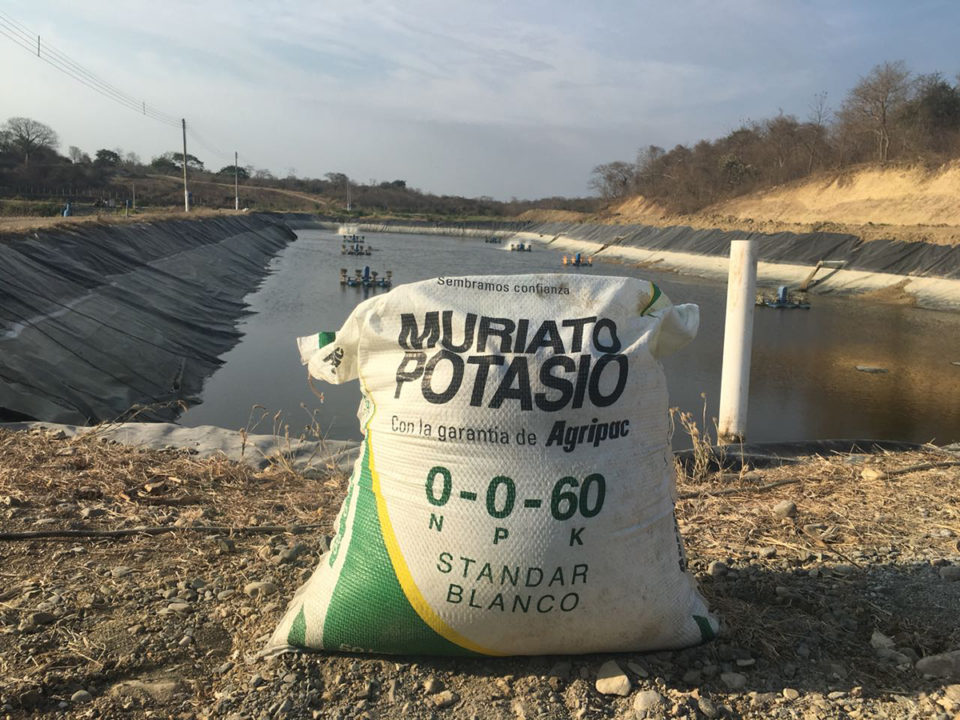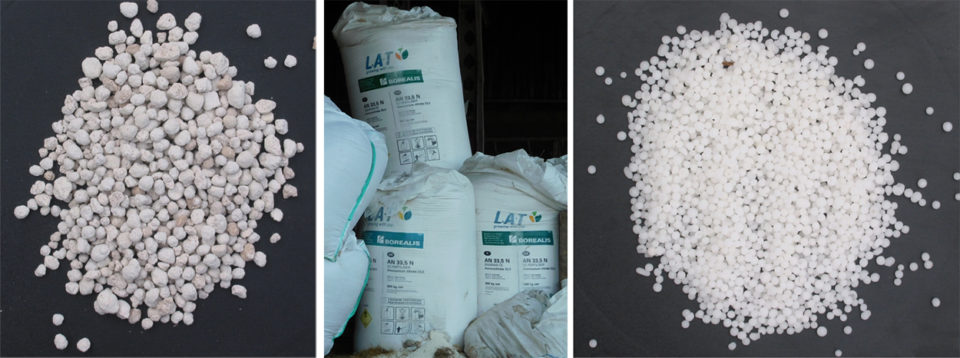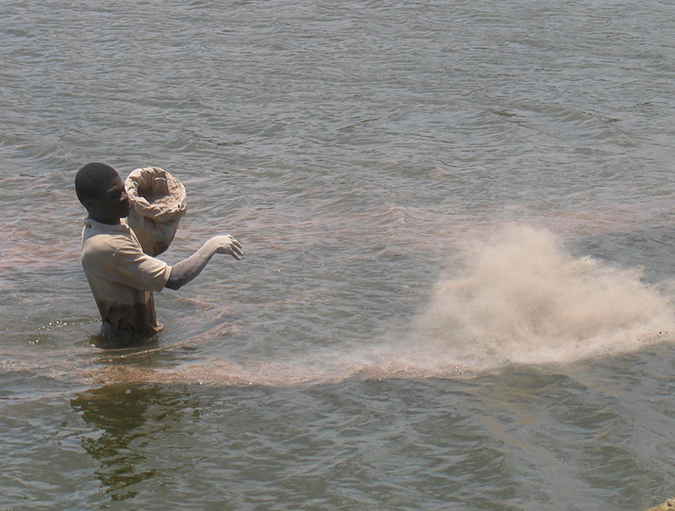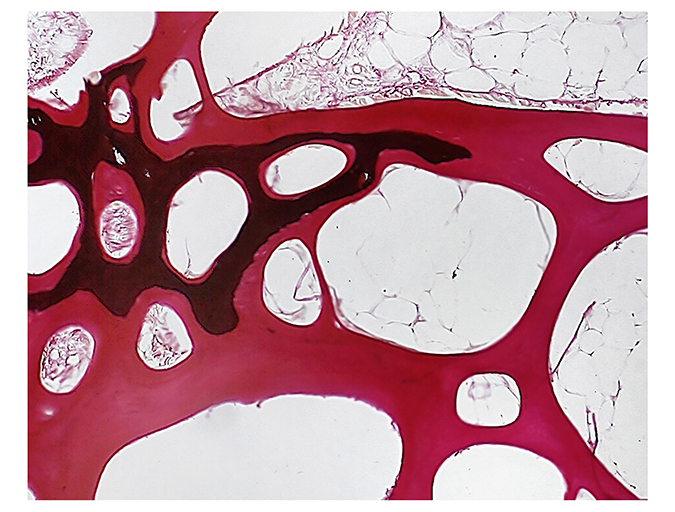Nitrogen and phosphorous are important promoters of primary productivity

Commercial fertilizers are widely used in aquaculture. Nitrogen and phosphorus fertilizers are necessary to encourage greater phytoplankton growth in ponds without feeding. They also are used early in the production cycle in feed-based pond production to stimulate phytoplankton that is the base of the food web providing natural food organisms beneficial to fish fry and shrimp postlarvae. Potassium fertilizers have received less use in aquaculture than have nitrogen and phosphorus fertilizers, but potassium may be beneficial to phytoplankton growth in some ponds. Potassium fertilizers also must be applied to increase potassium concentrations in some ponds for low-salinity, inland culture of shrimp and marine fish.
Types of fertilizers
Most nitrogen fertilizers are made from ammonia that is fixed industrially by reducing nitrogen gas from the atmosphere with hydrogen ion from combustion of natural gas or other fuels to yield ammonia. Ammonia can be altered through industrial processes to provide an array of nitrogen fertilizers. Some sodium nitrate is extracted from a mineral source found in the Atacama Desert of Chile.
Phosphate fertilizers are made from the mineral rock phosphate (apatite) that occurs in huge deposits in several areas of the world. Rock phosphate is converted to superphosphate by treatment with sulfuric acid. However, it is more common to treat rock phosphate with sulfuric acid and make phosphoric acid. Phosphoric acid can be used to make triple superphosphate from rock phosphate.
Potassium fertilizers are extracted from minerals rich in potassium or made by evaporation of brine from closed-basin lakes.
The most common commercial fertilizers are listed in Table 1. With the exception of liquid ammonium polyphosphate, commercial fertilizers are solids consisting of granules or small prills. They are denser than water, but water soluble.
Boyd, common fertilizers, Table 1
| Compound | N (%) | P205 (%) | K20 (%) |
|---|
Compound | N (%) | P205 (%) | K20 (%) |
|---|---|---|---|
| Urea | 45-46 | 0 | 0 |
| Ammonium nitrate | 33 | 0 | 0 |
| Ammonium sulfate | 21 | 0 | 0 |
| Calcium nitrate | 16 | 0 | 0 |
| Sodium nitrate | 15 | 0 | 0 |
| Diammonium phosphate | 18 | 46 | 0 |
| Monoammonium phosphate | 11 | 48 | 0 |
| Superphosphate | 16-20 | 0 | 0 |
| Triple superphosphate | 46-50 | 0 | 0 |
| Ammonium polyphosphate | 10-13 | 34-38 | 0 |
| Potassium nitrate | 0 | 0 | 44 |
| Potassium chloride | 0 | 0 | 60 |
The composition of fertilizers is given as percentages of nitrogen (N), phosphorus pentoxide (P2O5), and potassium oxide (K2O). This is a traditional method of reporting the nutrient element concentrations in fertilizer. The actual concentration of phosphorus and potassium in fertilizers can be obtained by multiplying percentage P2O5 by 0.437 and percentage K2O by 0.830. Nitrogen, phosphorus and potassium are called the primary fertilizer nutrients.
Urea is an organic compound that hydrolyses in water to ammonia nitrogen and carbon dioxide. Ammonium polyphosphate consists of ammonia nitrogen reacted with phosphate polymers. The polymerized phosphate hydrolyzes in water to regular orthophosphate. The other fertilizers simply dissolve into ammonium, nitrate, phosphate and potassium ions that are plant nutrients and their counter ions.
Three numbers representing the percentages of N, P2O5, and K2O in that order are known as the fertilizer analysis or grade. Some commercial fertilizers have only one primary nutrient (urea has the grade 45-0-0) and some have more than two primary nutrients. Diammonium phosphate has the grade (18-46-0). In agriculture, different quantities of basic fertilizers (Table 1) are mixed and a filler such as agricultural limestone added to obtain a specific percentage of each of the three, primary nutrients (N, P2O5, and K2O) in the mixture which is called a mixed fertilizer. For example, a mixed fertilizer with an analysis of 20-10-5 contains 20 percent N, 10 percent P2O5, and 5 percent K2O.

Applications of fertilizers
While it is convenient to use mixed fertilizers in agriculture, because the fertilizer can be distributed in a single pass near the planted seed through use of mechanical, fertilizer distributors, this practice is not necessary in aquaculture. One or more basic fertilizers are simply spread over the surface of ponds and the water currents distribute the nutrients.
In aquaculture, the two most commonly used commercial fertilizers are urea and triple superphosphate. They commonly are applied at rates of 5 to 10 kg N and P2O5 per hectare per application. In order to maintain adequate concentrations, fertilizers are applied at intervals of two to four weeks.
Fertilizer particles settle to the pond bottom before completely dissolving. It is advisable to pre-dissolve them in a container of water and splash the resulting solution over the pond surface. Liquid ammonium polyphosphate has a density of around 1.4 grams per cubic centimeter (g/cm3). It also should be pre-mixed with water to prevent it from settling without mixing completely in the water. Thus, in aquaculture, there is no particular advantage of ammonium polyphosphate over granular phosphate fertilizers.
Fertilizers usually are applied to ponds on a weight-per-area basis. There are recommendations for applying fertilizer on a concentration basis (milligrams per liter) in accordance with what someone considers adequate nitrogen and phosphorus concentrations for phytoplankton. Some recommendations may even take into account the pre-fertilization nutrient concentrations. This is a rather complicated approach, and it does not seem necessary for effective pond fertilization. The traditional applications of 5 to 10 kg N and P2O5/ha would correspond to concentrations of 0.33-0.67 mg/L of nitrogen and 0.22-0.44 mg/L of phosphorus in a 1-hectare by 1.5-meter-deep pond. Most ponds will be within the average depth range of 1.2 to 1.8 meters. Pond depth likely does not result in a wide variation in nutrient concentration among ponds following fertilizer applications based on area rather than volume.
The nutrient concentrations in ponds before fertilizers are applied also vary, and they would have to be measured to allow adjustments of concentration-based fertilizer applications. Moreover, fertilizer nutrients are removed from the water factors other than phytoplankton uptake. Weight per area calculations of fertilizer application rates seem a reasonable and less complicated approach.
Other considerations
Fertilizer applications should be made in response to phytoplankton abundance to avoid over-fertilization. Elaborate methods of assessing phytoplankton density such as chlorophyll a estimates and phytoplankton cell counts are not necessary. Water color and Secchi disk visibility observations can be used effectively to determine the appropriate time for fertilizer applications.
Fertilizers containing ammonia are potentially acid-forming, because when ammonia nitrogen is oxidized to nitrate nitrogen by nitrifying bacteria, hydrogen ion is released and neutralizes alkalinity as shown below:
NH4 + O2 –> NO3– + 2H+ + H2O.
The potential acidities of nitrogen fertilizers are presented (Table 2). Nitrate fertilizers are not potentially acid-forming.
Boyd, common fertilizers, Table 2
| Fertilizer | Potential acidity: (kg CaCO3/kg fertilizer) | Potential acidity: (kg CaCO3/kg N) |
|---|
Fertilizer | Potential acidity: (kg CaCO3/kg fertilizer) | Potential acidity: (kg CaCO3/kg N) |
|---|---|---|
| Urea | 1.61 | 3.57 |
| Ammonium sulfate | 1.51 | 7.19 |
| Ammonium nitrate | 1.18 | 3.58 |
| Diammonium phosphate * | 0.97 | 5.38 |
| Monoammonium phosphate * | 0.79 | 7.18 |
| Ammonium polyphosphate | 0.72 | 6.54 |
* Phosphate also can contribute to the potential acidity of fertilizers.
The potential acidity of nitrogen fertilizers will not usually be realized. Some ammonia is lost to the air by diffusion, a part is taken up by plants, and a portion is lost in outflow. Nevertheless, application of nitrogen fertilizers is a source of acidity in ponds.
Fertilizers are not particularly toxic, but they are concentrated chemicals. They should not be ingested and exposure to them may cause skin, eye, and respiratory irritations. They are subject to caking when exposure to moisture and should be stored in a dry place. Contact with rain can result in dissolution, and the resulting runoff will be highly concentrated with fertilizer nutrients leading to soil and water pollution. Nitrogen fertilizers – especially ammonium nitrate – can be both a fire and explosion hazard. Nitrogen fertilizers should not be stored near petroleum products or in areas with sparks or open flames.
Perspectives
The discussion above should be useful to those aquaculturists who use fertilizers in ponds. Fertilizers are expensive and their misuse can increase production costs, cause problems in ponds and result in pollution.
Now that you've reached the end of the article ...
… please consider supporting GSA’s mission to advance responsible seafood practices through education, advocacy and third-party assurances. The Advocate aims to document the evolution of responsible seafood practices and share the expansive knowledge of our vast network of contributors.
By becoming a Global Seafood Alliance member, you’re ensuring that all of the pre-competitive work we do through member benefits, resources and events can continue. Individual membership costs just $50 a year.
Not a GSA member? Join us.
Author
-

Claude E. Boyd, Ph.D.
School of Fisheries, Aquaculture and Aquatic Sciences
Auburn University
Auburn, Alabama 36849 USA
Related Posts

Responsibility
Inorganic fertilization of production ponds
Nitrogen and phosphorus are the most important nutrients in fertilization of both freshwater and coastal ponds. Many factors that can affect the response of ponds to fertilizers are location-specific. Aquaculture pond managers will have to figure out the best procedure for a given location or even for an individual pond.

Health & Welfare
Judicious use of phosphorous key to farmed fish health
Dietary phosphorus is essential for growth and healthy skeletal development of farmed fish. Fish health, limited availability and environmental concerns all urge modern aquaculture to handle phosphorous resources wisely and sustainably.

Responsibility
A look at various intensive shrimp farming systems in Asia
The impact of diseases led some Asian shrimp farming countries to develop biofloc and recirculation aquaculture system (RAS) production technologies. Treating incoming water for culture operations and wastewater treatment are biosecurity measures for disease prevention and control.

Aquafeeds
A look at phospholipids in aquafeeds
Phospholipids are the major constituents of cell membranes and are vital to the normal function of every cell and organ. The inclusion of phospholipids in aquafeeds ensures increased growth, better survival and stress resistance, and prevention of skeletal deformities of larval and juvenile stages of fish and shellfish species.

